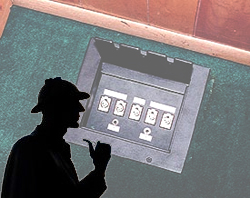
I popped off the stage plate covering the snake head and I couldn’t believe what I saw. Could this be the source of the problem?
Looking down, I saw the snake head lightly covered in sawdust from when the panel opening was cut out during the upgrade/renovation.
While I admit much of our audio upgrade was performed by volunteers, we had a great group of skilled workers. They would never saw over the audio snake head.
But then I noticed something that explained the sawdust…just below the opening was a support joist with a mound of sawdust.
As it turned out, the hole was cut before the snake was put in place but no one ever thought to clean off the sawdust from the joist. A few years of drums, electric bass, and a whole lot of walking on the stage was causing the sawdust to fall onto the snake head.
Vacuum
At this point, I still had not found the audio problem. But, confronted with what was before me, I had to clean up the mess. I vacuumed up the remaining sawdust on the joint and then turned my efforts to the snake head. After everything looked clean, I decided to go one step further.
Mystery Solved
I unplugged all of the cables going into the snake head, vacuumed out the remaining little amount of sawdust, and plugged everything back in place. Then I did a quick test of the microphone and IT WORKED!
It shouldn’t have worked. The XLR cable was securely seated in the snake head before I unplugged it. It had been working for years.
However, after unplugging, vacuuming, and reseating, it worked again. Some how, some way, the sawdust did something. Had it been there when the cables were first plugged in and something happened over time? Did moisture from humidity come into play? Was it something else I didn’t see?
OK, so the mystery of the problem was sort of solved. That signal path was now passing audio again. Who was I to question why?
Moral Of The Story
Whenever you encounter the odd problem that doesn’t have to impact your event, work around it, take note of it, and move on. When you do have the time to investigate the problem, take your time and work through the signal path. That’s how the source of most problem.
(See the first two installments of this series here.)
Ready to learn and laugh? Chris Huff writes about the world of church audio at Behind The Mixer. He covers everything from audio fundamentals to dealing with musicians. He can even tell you the signs the sound guy is having a mental breakdown.
